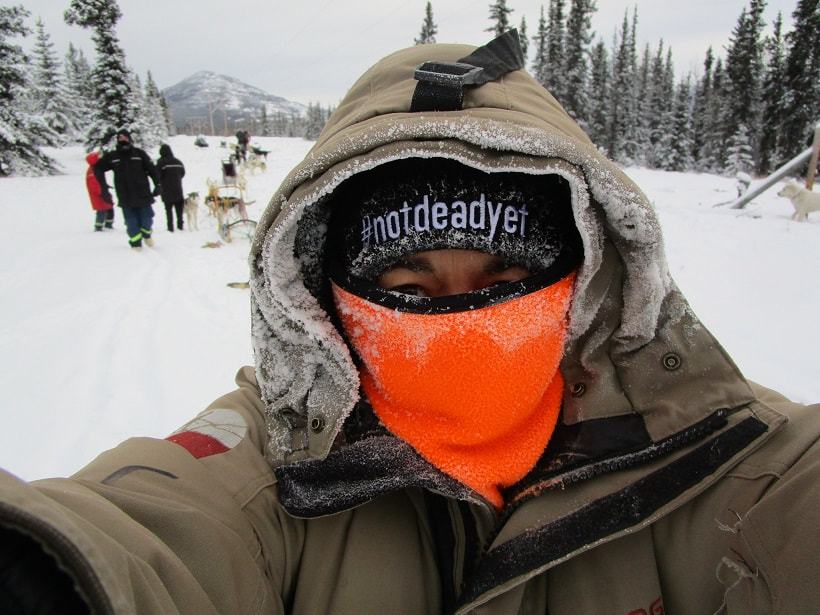|
I hobbled off my sled as we returned to the ranch following a 30km ride on our second day out with the dogs. When we left at 10.30am the temperature was hovering around -22 degrees Celsius and dropped to -30 by afternoon. Despite two pairs of socks and thick rubber boots, my toes and feet were numb and in excruciating pain. Heat warmer pads in our mits held the frostbite at bay during the day but had no effect in our boots. While I yearned for the warmth of our cabin and a hot cup of tea, I hung back to unharness the dogs, take their booties off, pack the sled and return it to the shed. I could barely walk. My tootsies were screaming with pain as I tenderly shuffled back to the house, frustrated by the effort of removing the doona-style pants first before fumbling with the boot laces. I called in reinforcements to remove the boots from my swollen feet. I practically crawled to the fireplace in the lounge. All the symptoms of frostbite were there: Stinging, burning and numbness; pain, throbbing, burning or an electric current-like sensation when the affected area is re-warmed. Oh, the pain! How c-c-cold is freezing? The week before our trip, temperatures in the Yukon had dropped to -32 degrees with warmer weather (up to -4 degrees) expected for our arrival the following week. Just goes to show you can’t rely on meteorology forecasts. On day 1 it was -20 degrees and by the third day it fell to -30 degrees. Fortunately, the heavy-duty ski pants and jacket supplied at the ranch - mostly supplemented with just one pair of thermals - kept my body reasonably warm. It was the extremities of fingers, toes and nose which bore the brunt of the freezing outdoor temperatures. On day 4 we woke to no running water. And a cold fireplace. The pipes had frozen overnight as the temperature plummeted to -50 degrees. We weren’t going anywhere with the dog sleds that day: -35 degrees is the cut off point for outdoor rides as it’s too cold for the dogs. And humans. And camping. So instead, we went out for a snowshoe walk after lunch. Despite the rather frosty -30 degrees, walking in the snow is quite a vigorous and warming exercise. In fact, snowshoeing can burn 420-1000 calories/hour depending on terrain, weight and speed. So I didn’t really need a second layer over my thermals! How to face-plant in the snow
Five minutes into our snowshoe walk, my left boot broke loose from the strap. Actually, it came away altogether. I was stuck in ankle-deep snow and unable to proceed uphill without snowshoes, so our heroic guide Gaetan ran back to the ranch for a replacement pair. Yes, he ran. With snowshoes on. Think of how many calories he burnt! As I strapped on my second pair, the plastic bit joined to the strap snapped on the left snow shoe; however, using some boy scout ingenuity Gaeton fastened the strap around the snowshoe frame (see above) which held for the rest of our walk through the picturesque forest. If you’re thinking tennis racquet style wooden snowshoes, think again. Modern snowshoes now feature aluminum frames and nylon decks, with smaller sizes and cleats underfoot. As with all assistive aids, though, there’s a technique to snowshoe walking… an effort which resulted in several face-plants in the snow (and not just me). Unexpected hazards of rugging up I wipe the seat from my forehead. Wait – what? Surely I’m not sweating in sub zero temperatures? It’s not like dog sledding is a physically challenging activity – after all, the dogs do most of the work. I wipe another layer of moisture from my eyes. I discover that hot air is rising up from the neck warmer covering my nose and mouth, causing: • Saturation of the material, which promptly freezes over. • Excessive moisture accumulating on my eyes (making sunglasses useless), eyebrows and beanie, all of which frost over with icicles, making blinking somewhat difficult. And then there’s that nagging dry cough from breathing in all that freezing air… Part 3: Whoa... stay... waaait!
2 Comments
1/2/2018 07:38:22 pm
Wow Hari..
Reply
Hari
1/2/2018 08:29:42 pm
Thanks Libby. More dog sledding insights coming up
Reply
Your comment will be posted after it is approved.
Leave a Reply. |
 Portuguese Camino 2019 Portuguese Camino 2019
Travel blogs
New Zealand 2008 Tibet 2007 New Zealand 2006 Melbourne 2006 United Kingdom 2004 Athens Olympics 2004 Peru 2003 Beijing to Athens 1994 Nepal 1991 Categories
All
Archives
December 2019
|
|
I acknowledge the traditional Custodians of the land on which I work and live, the Gubbi Gubbi / Kabi Kabi and Joondoburri people, and recognise their continuing connection to land, the waters and sky. I pay my respect to them and their cultures; and to Elders past, present and emerging.
|
© 2024 HARI KOTROTSIOS
|






